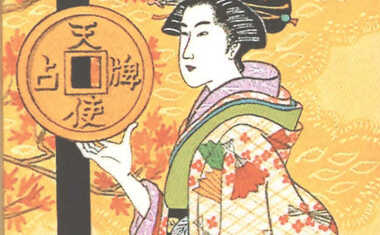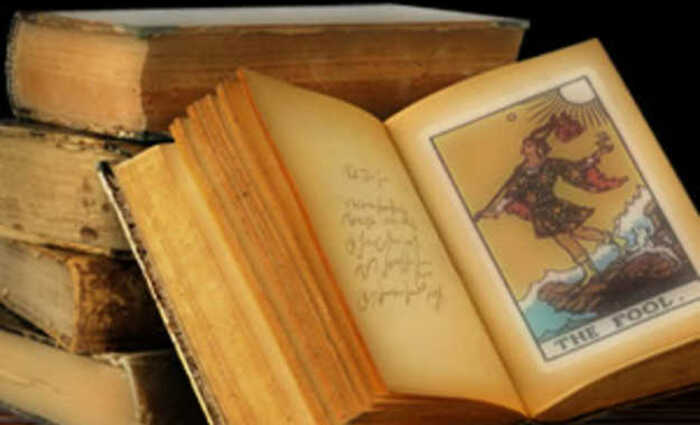
Empress Cards
The Iconology from 15/16th Century
In the early ordering (Type B) of the Tarot trumps, the Empress card appears as trump #2. With the Empress card we move from the lowest estates of man, represented by the Fool and Bagatto, to the highest. In all of the 15th/16th century orderings, the next four cards are always found together as a group though their numerical values differ. The quartet represents the highest positions that a man or woman can achieve in the lay and cleric social hierarchies of the late Medieval and early Renaissance period.
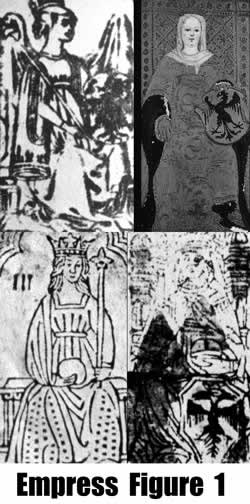 Figure 1 shows the four surviving Empress cards from the 15/16th century period. The images always show an enthroned woman with a crown and scepter. Such formal portraits of Empresses, such as Theodora (1) date back to Roman times (Grabar 1968, fig. 201). In two of the early tarot cards, she holds an orb and in three cases she is shown with a shield bearing the Black Eagle, the heraldry symbol of the Holy Roman Emperor. In one image, the eagle is doubled, a heraldry device reserved for the Emperor. In the other two images, the eagle is single-headed. The Emperor allowed the use of the single-headed eagle as a heraldry device to certain vassals, such as the duke of Milan.
Figure 1 shows the four surviving Empress cards from the 15/16th century period. The images always show an enthroned woman with a crown and scepter. Such formal portraits of Empresses, such as Theodora (1) date back to Roman times (Grabar 1968, fig. 201). In two of the early tarot cards, she holds an orb and in three cases she is shown with a shield bearing the Black Eagle, the heraldry symbol of the Holy Roman Emperor. In one image, the eagle is doubled, a heraldry device reserved for the Emperor. In the other two images, the eagle is single-headed. The Emperor allowed the use of the single-headed eagle as a heraldry device to certain vassals, such as the duke of Milan.
As the highest estate of woman, the Empress frequently appears as an allegorical figure. For example, Venus is represented as an Empress in medieval manuscripts (2) (see also, Seznec 1953, Fig. 61). In a woodcut of ~1500 we find the enthroned Empress representing Philosophy (Fig. 2). Here she holds books in her lap rather than orb or shield, but the image is still recognizable. Other images show the Empress as Wisdom (3). In an example from 1556, she appears as as the personification of Knowledge or Wisdom enthroned atop a castle (Fig. 3). The Empress also appears as the personification of the female principle in 16th century alchemical texts (4).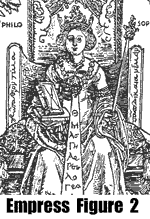
The religious tradition
The allegorical use of the Empress figure continues into religious art where the Empress is used as a personification of the Church (5), (6), (7) . Figure 4 shows a 12th century example in which the crowned woman, catches blood from the crucified Jesus. In this symbol of the Church, the Empress is enthroned on the tetramorph, a symbol whose four heads and legs represent the four evangelists of the New Testament.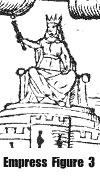
The most common religious image would have been of the Madonna enthroned as Queen/Empress of Heaven (8). Figure 5 shows an example from the Lateran Palace in Rome (12th century). This image is particularly interesting because of the wings of the two angels standing behind the main figure. I have often wondered if the angel wings were transformed into the draped throne behind one of the early Empress images (Fig. 1) and whether the angel wings were eventually transformed into wings on the Empress herself in later decks.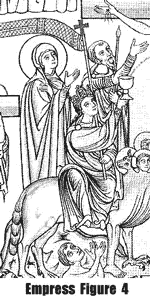
Another image of the enthroned Madonna is given in Figure 6 from Pisa. Notice that in this case, the image is enclosed in a mandalora. Additional examples of this framing are given in Figs. 9 and 10 in the chapter on the World card. Further examples of the enthroned Madonna can be found in Ferguson(1954, Plate 30) and Meiss (1970, p. 59).
In addition to these images of the enthroned Madonna, there are also a wealth of images of the Coronation of the Virgin. Examples can be found in Meiss (1951, Plates 54-57), Paoletti and Radke (1997, Figs. 1.41, 2.11, 3.22, 4.17. 4.55), and Cole (1980, Plates 7, 8, 13, 33, 36, 40, 66). These images typically show Mary and Jesus on adjacent thrones with Jesus placing the crown onto Mary's head. The images do not resemble the early Tarot as much as Figs. 5 and 6. Nevertheless, the images were so common that the association of the early Empress cards with the coronation and enthronement was quite likely.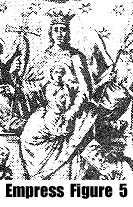
The Triumphal tradition
The Empress does not enter into Petrarch's poem. The closest reference might be found in the Triumph of Love. Discussing the captives of Love, Petrarch honors Caesar: "First of us all, is Caesar, whom in Egypt Cleopatra bound, amid the flowers and grass." But the identification of Cleopatra with the images in Fig. 1 seems tenuous at best.
In the artistic tradition of the Triumphs, the Triumph of Love is often associated with the illustration of the various 'captives' over whom Love has triumphed. However, I am not aware of any imagery that shows the Empress as one of the captives.
In some of the triumphal imagery, not directly derived from Petrarch, one can find women representing Minerva or Venus enthroned atop a triumphal chariot. However, the symbolic accoutrement associated with these images is quite different from the early tarot images.
The dance of death tradition
As one of the highest estates of humankind, the Empress does enter into the Dance of Death tradition (9), though not in every example. Williams (1994, p. 89) shows a woodcut of Hans Holbein the Younger (~1518). The Empress is being led to her grave by death dressed as an old hag.
The Apocryptic tradition
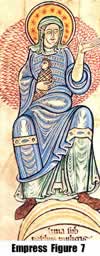
The Empress image may be related to Revelations 12:1 "...a woman clothed with the sun, standing on the moon, and with the 12 stars on her head for a crown." The feasibility of a connection is reinforced by several things. First, the Woman of the Apocalypse was interpreted to be Mary by exegetes of the Church and this would tie into the resemblance between the early cards and the enthroned Madonna. Second, in the apocalyptic literature of the period, the final age would begin with the formation of a new world order under the rule of the Holy Roman Emperor and this would tie into the black eagle on the early cards.
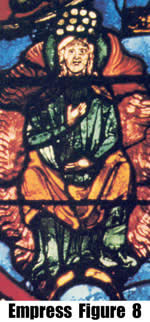
The apocalyptic tradition contains a wealth of images illustrating Revelations 12:1 that bear a resemblance to the early Tarot Empress (10), (11). Figure 7 is an early (12th century) example that shows the woman seated and with the sun behind her, a crown of 12 stars and the moon at her feet. Figure 8 is a stained glass window from the 13th century in which the crown of stars looks rather like a papal tiara. Perhaps the most impressive of these images of the woman is on an altarpiece ~1432. The image is shown in Figure 9. In this representation, the woman wears an elaborate crown and the 12 stars can be seen floating above and behind the crown.
Other relevant images of the Woman of the Apocalypse can be found in Meiss (1951, Plate 164, 13th century) and in van der Meer (1978, Plate 16, 13th century; Plate 60, ~500; Plate 67, ~1000, Plate 75, 1047; Plate 108, ~1245; Plate 149, 15th century).
Iconological analysis
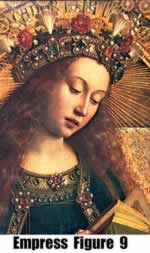
Images of the Empress, as the highest estate of lay women, were common in the late Medieval period. Images resembling the early Tarot were used as personifications of philosophy, knowledge, and the Church. An urban resident of Northern Italy could not fail to be familiar with the universal images of the Coronation and the enthroned Madonna.
Mendicant preachers of this period, particularly the Spiritual Franciscans, laid great emphasis on the coming Apocalypse. In the literature of the time, the new age would be marked by the rise of a great universal leader, usually identified with the Holy Roman Emperor. Therefore, the black eagle on the early tarot images might well have been identified with the coming Age of the Holy Spirit. So in the context of the period, the association of the Holy Roman Empress with the Woman of Revelations 12:1, would not have been as far-fetched as it may seem to us today.
Interpretation
The immediate impression that the Empress card would have had on the 15th century card-player was the highest ranking woman, the Holy Roman Empress. Indeed, the image of the Empress is often immediately associated with the image of the Emperor (12) The immediate associations would probably have been maternal and benevolent.
Secondary impressions might have referenced the many images that the card-player had been exposed to of the enthroned Madonna and the Woman of the Apocalypse. These might have elicited reactions typical of the maternal archetype: merciful, protective, loving.



